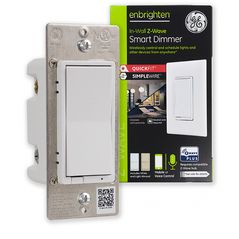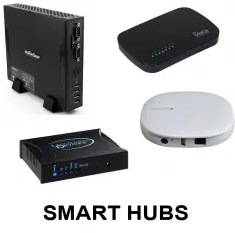Smart Home Lighting Without a Smart Hub
Monday, July 26, 2021 — 0 Comments
Traditionally smart home lighting involves installing one or more smart light switches in place of a traditional switch. This light switch would use a technology like ZWave or Zigbee. The switch would talk to a smart home hub which in turn was connected to the home's WiFi network to provide control from a web browser or app based control on a smart phone.
Smart Home Lighting Without a Smart Hub
Smart home hubs provide very powerful automatation and integration but not every smart home needs a hub. Insteon for example can provide whole home lighting with scenes and keypad controls without requiring a hub. The hub is still required to enable smart phone control or scheduled lighting. It's optional.
WiFi devices on the other hand don't require a dedicated smart home hub. They use the home's existing WiFi to communicate. A cloud service will then take the place of an in-home hub to provide remote access and app control from a smart phone.
Need Voice Assistant Control?
Most WiFi smart home switches, dimmers and plugs can be easily integrated with Alexa or Google voice assistants without needing a smart home hub. The user can simply command their voice assistant to turn lights or groups of lights on and off. Often times this opens the door to integrating other smart devices that are supported by Google Home or Alexa.
Lighting Schedules
In most cases, WiFi Switches and Dimmers can be programmed with schedules based on sunrise, sunset, or time of day. This scheduling is most often saved in the smart device so it will activate reliably even if the home's Internet connection fails.
Scene Lighting
While most WiFi smart devices provide app control, some brands are taking the technology a step further to provide additional enhancements. Leviton's Generation 2 WiFi switches and dimmers for example can be controlled by a Bluetooth enabled remote switch to create virtual 3 way lighting or easy remote control without using WiFi communication.
Leviton has also introduced WiFI multi-button scene control keypads to allow the user to control various Leviton smart switches from a single keypad location.
Leviton's dimmer with built-in Alexa voice assistant offers a unique form factor that lets the user have Alexa voice control without having a plug-in device on the counter.
When Is A Smart Hub Required?
So why would anyone want a smart hub? Generally speaking, a hub can enable much more advanced home automation and integration that can't be done without the hub. Also some users would prefer to keep their smart home "off the cloud" so they will use a hub that runs its programming locally. Hubs like Hubitat or Hometroller are examples of hubs that don't require a cloud connection. But they still support remote control and cloud access.
Most smart home hubs support multiple technologies or "radios" so they can work with ZWave or Zigbee devices. WiFi is great, but there is a much larger ecosystem of motion sensors, door/window sensors, light sensors, and so on that don't operate on WiFI. The smart home hub can bring multiple technologies together to create lighting triggers based on motion or doors opening for example. Or a ZWave water valve can close immediately in the case a water sensor detects a leak. These local integrations don't need to rely on a working Internet connection so they are fast and reliable. The hub can also add conditional if/then/else type logic that's difficult to replicate with a cloud service.
When using a smart home hub, the hub can typically be tied in to Google or Alexa smart home assistants, allowing control of the lights, scenes or other devices like door locks.
Conclusion
Smart home automation without a hub is a practical alternative to hub based systems where the intent is to create scene lighting or lighting schedules. It's also well suited to control by voice control assistants or app control of the home's lights.





